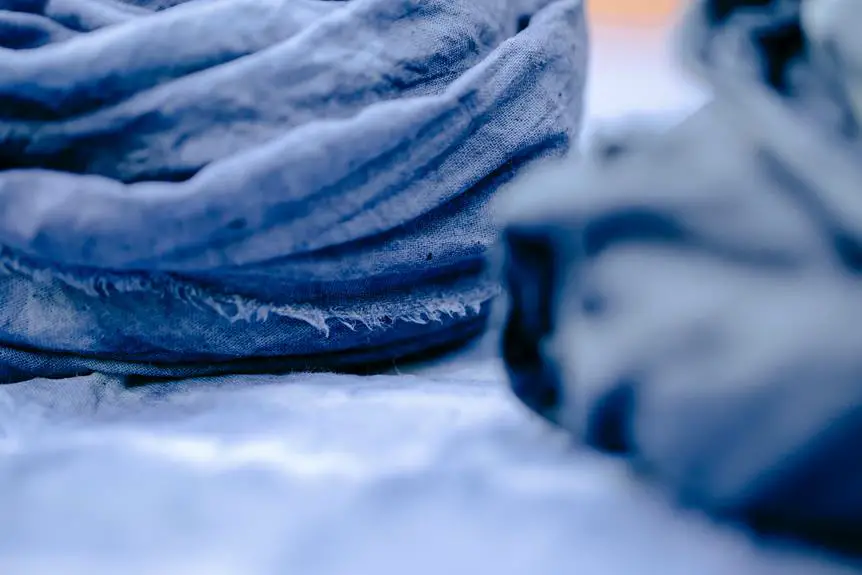Reviving your black clothes is like giving them a second chance to shine. If you've noticed your favorite black garments looking a bit faded, re-dyeing them can make them look as good as new.
This guide will walk you through the process of re-dyeing fabric with precision and care. From assessing the condition of the fabric to selecting the right dye and ensuring the color sets perfectly, you'll learn the techniques to revive your black clothes flawlessly.
With a few simple steps, you can breathe new life into your wardrobe and keep your black garments looking fresh and vibrant.
Let's get started on reviving your black clothes!
Key Takeaways
- Assess the fabric condition for signs of fading, wear, and damage on black clothes.
- Select the right fabric dye by considering compatibility with the original fabric and conducting color fastness testing.
- Consider the fiber content of the clothing when choosing a fabric dye and understand the different dye application methods.
- Different fabric types require specific dyes for optimal results, such as silk requiring a gentle dyeing process and synthetics needing dyes formulated for them.
Assessing Fabric Condition
Before you begin the process of re-dyeing your black clothes, assess the fabric's condition by examining for signs of fading, wear, and damage.
Start by looking for any areas where the black color has visibly lightened or dulled. Pay attention to high-friction areas such as the collar, cuffs, and seams, as these are common places for fading to occur.
Next, check for any signs of wear, such as thinning or fraying of the fabric. This can indicate that the fabric may not be able to withstand the re-dyeing process.
Additionally, inspect the fabric for any damage like holes, tears, or fabric thinning, as these issues may need to be addressed before re-dyeing.
If the fabric has significant wear or damage, it may be best to consider other options such as patching or repairing the garment instead of re-dyeing.
Thoroughly assessing the fabric quality and conducting a color fading analysis will help you determine whether the garment is suitable for re-dyeing or if alternative solutions are necessary.
Selecting the Right Fabric Dye
When selecting the right fabric dye, it's essential to consider the compatibility of the dye color with the original fabric. Different fabric types may require different types of dye, so it's important to take the fabric material into account.
Additionally, understanding the various dye application methods will help you achieve the best results when re-dyeing your black clothes.
Dye Color Compatibility
You should always carefully consider the color compatibility when selecting the right fabric dye for re-dyeing your black clothes. Start by conducting color fastness testing to ensure the original dye won't bleed or alter the new color.
It's crucial to choose a fabric dye that's compatible with the fiber content of your clothing. Consider fabric dyeing techniques and color blending options to achieve the desired shade. Some dyes are specifically formulated for natural fibers like cotton and linen, while others work best on synthetic fabrics such as polyester and nylon.
Understanding dye compatibility is essential to avoid color discrepancies and achieve optimal results. Take the time to research and select a fabric dye that complements the original color and material of your clothing for a successful re-dyeing process.
Fabric Type Considerations
Consider the fiber content of your clothing when selecting the right fabric dye for re-dyeing black clothes. Different fabric types require specific dyes to achieve the best results.
When considering silk, keep in mind that it's a delicate fabric that requires a gentle dyeing process. For polyester fabrics, look for dyes specifically formulated for synthetics to ensure proper color absorption.
Keep in mind that silk considerations involve using acid dyes, as they work best with protein fibers like silk and produce vibrant colors. On the other hand, polyester options include disperse dyes, which are designed to effectively color synthetic fibers like polyester.
Understanding the fabric type is crucial in choosing the appropriate dye to successfully revive your black clothing.
Dye Application Methods
Once you have identified the fabric type of your clothing, it is essential to select the appropriate dye application method to ensure successful re-dyeing of your black clothes. There are various dye application methods to consider, each with its own advantages and best uses. The table below outlines the different dye application methods and their characteristics:
| Dye Application Method | Description |
|---|---|
| Immersion Dyeing | Submerging fabric in dye for overall coloration |
| Direct Application | Applying dye directly onto specific areas for targeted color restoration |
Choosing the right dye application method is crucial for achieving optimal dye penetration and fabric color restoration. Consider the nature of your clothing and the desired outcome when selecting the appropriate method. This careful consideration will ensure that your black clothes are revived to their former glory.
Preparing the Fabric for Dyeing
Before diving into the dyeing process, start by carefully reading the fabric washing instructions. This will ensure you're using the right cleaning method for the material.
Next, remove any old dye by washing the fabric in hot water with a color remover product.
Fabric Washing Instructions
To prepare the fabric for dyeing, start by washing it in the washing machine with hot water and a mild detergent. This step is crucial for ensuring proper fabric color retention and achieving an even dyeing result.
When washing the fabric, consider the following:
- Washing Machine Settings
- Set the washing machine to the hottest water setting suitable for the fabric type to ensure optimal dye absorption.
- Use a mild detergent to clean the fabric thoroughly without leaving behind any residue that may affect the dyeing process.
Removing Old Dye
After washing the fabric, assess its color for any remaining dye before proceeding with the next steps.
To remove stubborn stains or old dye, consider using color fading solutions. One effective method is to soak the fabric in a mixture of hot water and color-safe bleach or a commercial dye remover, following the product's instructions carefully.
For natural fibers like cotton or linen, you can also try using a mixture of vinegar and water, or a solution of oxygen-based bleach. Test any solution on a small, inconspicuous area first to ensure it doesn't damage the fabric.
After treating the fabric, thoroughly rinse it and let it dry completely before moving on to the dyeing process.
Removing old dye is crucial to achieve an even and vibrant result when re-dyeing your fabric.
Checking Fabric Condition
Assess the fabric's color and texture to ensure it's in good condition for dyeing.
- Color:
- Look for any fading, discoloration, or uneven patches on the fabric.
- Ensure the current color is consistent and free from any stains or spots that may affect the new dye.
- Texture:
- Feel the fabric for any signs of wear, tear, or thinning, especially in high-friction areas like elbows or knees.
- Check for any pilling or rough patches that may impact the dyeing process.
Assessing fabric integrity is crucial to achieving an even and vibrant dye result. By carefully examining the fabric's color and texture, you can identify any potential issues that may affect the dyeing process and address them before proceeding with fabric dyeing techniques.
Mixing and Applying the Dye
First, obtain a black fabric dye suitable for your garment material and follow the manufacturer's instructions for mixing the dye solution. When mixing the dye, ensure that it's thoroughly dissolved in the water to achieve an even color application.
Use a stainless steel or plastic container for the dye bath, and wear gloves to protect your hands from staining. Submerge the garment completely in the dye bath and stir continuously for even dye penetration. For a deeper black shade, extend the dyeing time, but be cautious not to over-dye, which may result in a faded appearance over time.
After dyeing, rinse the garment thoroughly with cold water until the water runs clear, then wash it separately with a mild detergent to remove any excess dye. When applying the dye, make sure to work in a well-ventilated area and protect your work surface from potential spills or splatters.
Avoid common mistakes such as using too little dye, inadequate stirring, or uneven application, as these can lead to splotchy or faded results. By mastering these dye mixing techniques and application tips, you can effectively revive the color of your black clothes.
Setting the Dye in the Fabric
Once the fabric has been thoroughly dyed and rinsed, you'll need to set the dye in the fabric to ensure long-lasting color retention. To achieve maximum color fastness and dye retention, follow these steps:
- Heat Setting:
After rinsing the fabric, place it in the dryer on the highest heat setting suitable for the fabric for about 30-60 minutes. This will help to set the dye in the fabric fibers and enhance color retention.
- Ironing:
Iron the fabric using a hot iron and a pressing cloth. The heat from the iron will further set the dye into the fabric, improving its color fastness.
By heat setting the fabric and ironing it, you can significantly improve the color fastness and dye retention. These steps are crucial to ensure that your newly dyed fabric maintains its rich color for a long time.
Remember to always follow the specific dye manufacturer's instructions for the best results.
Rinsing and Washing the Fabric
To ensure the dye is properly set and any excess dye is removed, thoroughly rinse the fabric in cold water before washing it with a mild detergent. After allowing the fabric to soak in cold water for a few minutes, gently wash it with a mild detergent to remove any remaining dye particles. When rinsing the fabric, ensure the water temperature remains cold to prevent the dye from bleeding. Once the fabric is thoroughly rinsed, you can proceed to wash it with a mild detergent. After washing, carefully inspect the fabric to ensure the dye has set and the color is even.
Fabric Rinsing and Washing Guidelines
| Fabric Rinsing | Fabric Washing |
|---|---|
| Use cold water | Use mild detergent |
| Gently agitate the fabric | Wash gently |
| Check for dye bleeding | Inspect for even color |
| Ensure thorough rinsing | Avoid harsh chemicals |
| Pat dry with a clean towel | Air dry or tumble dry on low heat |
After the fabric is rinsed and washed, pat it dry with a clean towel to remove excess water. Then, proceed with air drying or tumble drying on low heat to prevent any damage to the fabric.
Caring for Re-Dyed Clothes
After re-dyeing your clothes, it's important to carefully follow care instructions to maintain the color vibrancy and fabric quality. Here are some essential tips for caring for re-dyed clothes:
- Washing:
- Use a gentle detergent specifically formulated for dark colors to prevent color fading.
- Wash your re-dyed clothes in cold water to help maintain the color vibrancy and prevent shrinking.
- Drying:
- Air dry your re-dyed clothes whenever possible to prevent damage from high heat.
- If using a dryer, set it to a low heat or delicate cycle to maintain the fabric quality and color intensity.
By following these care tips, you can prolong the vibrancy of your re-dyed clothes and ensure that they continue to look their best.
Frequently Asked Questions
Can I Dye a Fabric That Has Already Been Dyed Multiple Times?
Yes, you can redye fabric that has been dyed multiple times, but there are limitations. Color stripping techniques may be necessary to achieve desired results. Be mindful of the fabric's condition and previous dyeing.
What Is the Best Way to Remove Old Dye From Fabric Before Re-Dyeing It?
Before re-dyeing, removing old dye is crucial for fabric preparation. Use a dye remover or color stripper to effectively remove the old color. Follow the product instructions for best results, ensuring a clean base for re-dyeing.
Can I Use Natural Dyes, Such as Coffee or Tea, to Re-Dye My Black Clothes?
Yes, you can use natural dyes like coffee or tea to re-dye your black clothes. They offer eco-friendly options and are cost-effective. However, their colorfastness may vary, so consider alternative methods for a consistent result.
Will Re-Dyeing My Fabric Cause Any Damage to the Fabric's Texture or Quality?
When re-dyeing fabric, take precautionary measures to protect the fabric's texture and quality. Proper fabric preparation, such as thorough washing and testing the dye, can help minimize any potential damage and ensure a successful outcome.
Are There Any Special Considerations or Precautions I Should Take if I Plan to Re-Dye a Fabric With Embellishments or Decorative Elements?
When re-dyeing fabric with embellishments, take precautions to protect them. Consider fabric quality and potential effects of multiple dyes. Be wary of dye removal and use caution with natural dyes. Always test in an inconspicuous area first.
- Is a Herringbone Fabric Headboard a Good Choice for Your Bedroom? - June 19, 2025
- Styling Tips for Men’s Herringbone Fabric Clothing - June 19, 2025
- The Difference Between Herringbone Weave and Herringbone Print Fabric - June 19, 2025





